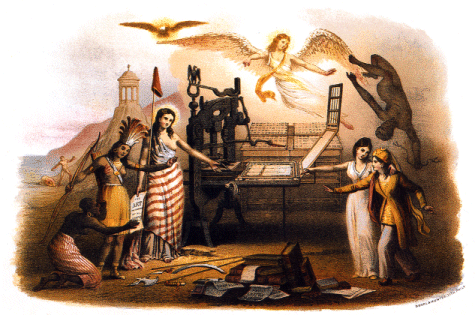May 5 - July 31, 1999
Stamped With a National Character:
Nineteenth-Century American Color Plate Books
Curated by William Reese
 To mark the bicentennial of the first color plate book produced in the United States, The Grolier Club will exhibit over one hundred books with color plates printed in the Americas during the 19th century. The show will trace the development of the use of color illustration in books from tentative beginnings to the invention of chromatic halftones, exploring both the evolution of printing processes and the uses of color plate books in cultural and scientific contexts.
To mark the bicentennial of the first color plate book produced in the United States, The Grolier Club will exhibit over one hundred books with color plates printed in the Americas during the 19th century. The show will trace the development of the use of color illustration in books from tentative beginnings to the invention of chromatic halftones, exploring both the evolution of printing processes and the uses of color plate books in cultural and scientific contexts.
The first American color plate book, William Birch's The City of Philadelphia in the Year 1800, was printed from engraved copper plates, which were then colored by hand. As technologies evolved, plates were produced by woodcut, aquatint, lithograph, chromolithograph, photolithograph, photogravure, nature printing, and chromatic halftone. This final process, which first appeared in an American book in 1896, opened the door to the technology which dominated color printing for most of the 20th century, and doomed the earlier forms to obsolescence.
Color plate books covered a wide spectrum of genres and were aimed at an equally broad range of audiences. The show will include books addressing natural history, view books, illustrations to fiction, drawing instruction, Native Americans, fashion, gift books, children's literature, geology, travel narratives, medicine, displays of statistical data, chemistry, home decoration, architecture, landscaping, botany, typography, religious works, art history, trade catalogues, sporting books, and color theory.
Many extraordinary and beautiful color plate books were produced in the United States in the 19th century (representative examples of work from elsewhere in the Americas is also shown). However, the country's work remained a poor relation to European printing throughout the period. Many advances were provided by the immigration of craftsmen from Germany, France and England. The trans-Atlantic flow of both artists and printing materials is a significant aspect of the story, as is the struggle of American printers to advance the quality of their productions to rival any in the world.
The boldest entrepreneurs in color plate book publishing were the Audubons. Together, John James Audubon and his sons produced the grandest projects of the century. Their octavo edition of The Birds of America was a huge commercial success, and their folio and octavo editions of The Quadrupeds of America were the largest completed color plate job of the century. But their fortunes were wrecked on their last endeavor, an attempt to reprint the elephant folio of The Birds of America in New York. The story of these books is among those told by the exhibition.
Stamped With a National Character: Nineteenth-Century American Color Plate Books provides a fascinating viewpoint on the evolution of culture and technology in the United States. The Grolier Club is planning a series of events, including lectures and gallery walks, to provide commentary on the exhibition.
The exhibition is curated by William S. Reese, and will be on view at the Grolier Club, 47 East 60th Street, May 5 - July 31, 1999, except May 31 and July 5 when the Club is closed. The exhibition is open to the public, Monday-Saturday, 10 am-5 pm, free of charge.
A hardcover illustrated catalogue of the exhibition is available.